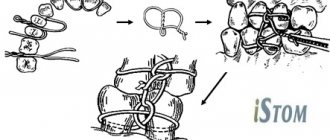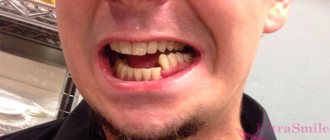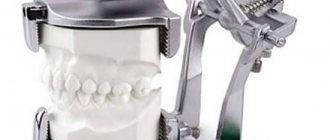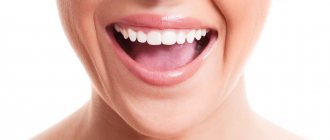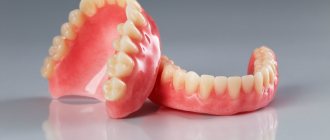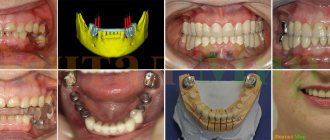Price
- Primary appointment (examination, consultation) with a dentist (special offer) 100001
For free
Promotion
- Dental prosthetics Complete removable plate dentures 153003
35 000 ₽
- Manufacturing of removable dentures from Thermoplastic material 153005
49 000 ₽
- Dental prosthetics using implants Acrylic covering prosthesis with a cast frame made of CoCr alloy (excluding the cost of fixing elements: locators, spherical abutments) 154001
60 000 ₽
- Prosthetics of all jaw teeth on 4 implants
149 900 ₽
Promotion
A complete removable denture is an orthopedic design that simulates the upper or lower dentition in the absence of all teeth. Its base imitates gums and ensures fixation of the device. Artificial crowns are soldered into the base. There are removable complete dentures and conditionally removable ones. The patient can independently remove the first ones at any time. Conditionally removable structures are fixed on implants and can only be removed by a doctor. The method of prosthetics is selected taking into account the nuances of the clinical case and the patient’s preferences.
Overlay technique
To make the device, thick fabric or synthetic material is used. The structure can be installed in the office or at home, but in any case, supervision by a doctor is required. Overlay algorithm:
- the specialist faces the Patient, the patient’s head should be aligned;
- a napkin is applied to the chin, then a correction island;
- the ends of the sling are fixed to the head of the structure;
- When fastening, you need to monitor the tightness of the installation; the fixation should not be too strong, as this causes discomfort when wearing and impaired breathing functions.
The design is made on the basis of casts and the results of preliminary research. The device must correspond to the anatomical features, the degree of pathology and the desired result. For home application, you can purchase ready-made standard products. But they should only be purchased at specialized outlets and after prior consultation with an orthodontist.
Terms of wearing
When treating class 3 anomalies, it is recommended to use just such a device. But when installing children, clinical observations show that there is a delay in body growth and development of the lower jaw, although they are insignificant. If the correction is interrupted, a partial relapse occurs. That is, the jaw returns to the pathological position and moves forward. For this reason, doctors recommend using a sling only during the period of temporary occlusion. The wearing period is significant - three to four years from 12 hours daily. In addition, an integrated approach is required. This is the simultaneous use of myogymnastics methods, fixation of extraoral and intraoral apparatus.
Caring for the product is simple, you just need to remove the structure, rinse it in warm water, and dry it. To treat the mouth guard, it is recommended to use special disinfecting liquids.
The cost of therapy is:
- sling for immobilization after a fracture or orthodontic correction – from 2800 rubles;
- a hat with a special device - 1.5-5 thousand rubles.
Before installation, the doctor conducts a complete diagnosis and determines what type of device will be used. A treatment regimen and additional procedures will also be drawn up. In general, the cost of pathology correction, excluding the price of the device itself, is about 8-35 thousand. The exact prices depend on many factors; the doctor will be able to name the cost only after receiving the examination results.
Types of removable dentures in complete absence of teeth
Plate acrylic
Classic acrylic insert jaws are made of hard plastic. Fixation is ensured by a wide lamellar base. When biting, air comes out from under the base and a suction effect occurs. Pros: affordable price, maintainability, aesthetics. The disadvantages include deterioration of fixation as the contours of the prosthetic bed change with the need for relining, large sizes, and the need to adapt to the device. Plastic contains monomers that can cause allergies. Artificial teeth absorb dyes and odors, and after 2-3 years they lose their aesthetic properties.
Acry-Free
Monomer-free plastic Acri Free, produced in Israel, is more elastic than acrylic and does not cause allergies. Products from it are made using the injection molding method, which ensures precise fit of the base to soft tissues, as well as tight fixation. The compactness and translucency of the artificial gum make the false jaw convenient, comfortable, and aesthetically pleasing. The resistance of the structure to chewing loads prevents damage to soft tissues and also somewhat slows down atrophy. Orthopedic devices from Akri-Free are recognized as the best alternative to plastic false jaws, but they cost more.
Nylon
The main characteristic of the material of nylon prostheses is elasticity. The base is thinner, softer, and more compact than plastic, which makes false teeth comfortable for the patient. The translucency of the base ensures aesthetics. However, softness is also a disadvantage of nylon. The base quickly loses its shape, which negatively affects fixation. The device cannot be repositioned. During chewing of food, the load is not distributed, but is locally transferred to soft tissues, which causes pain in patients. The porous material absorbs dyes and changes the smell.
Which is better
The main characteristics of acrylic, nylon and Akri-Free prostheses are presented in the table below.
| Property/material | Plastic | Akri-Free | Nylon |
| Life time | 2.5-5 years | 5-7 years | 1-5 years |
| Aesthetics | average | high | high |
| Fixation | satisfactory | good | unsatisfactory |
| Dimensions | large | compact | compact |
| Repair | available | available | not possible |
| Flexibility | low | optimal | high |
| Strength | satisfactory | high | satisfactory |
| Allergy | possible | No | possible |
Among modern removable covering structures, products made from Acri-Free are considered optimal. Compared to them, plate apparatuses are very large, heavy, change taste perception, and require adaptation over the course of 2 weeks. Nylon quickly loses its shape, aesthetics, and quality of fixation. They will soon have to be changed, while devices from Acre-Free can simply be adjusted.
Bridle bandage
Bridle bandage on the jaw
Another way to secure the affected area is with a jaw bandage. This bandage provides stronger fixation of the lower jaw compared to a sling bandage. This occurs by performing additional turns of the bandage around the head.
The bridle can be used for various injuries:
- facial area;
- lower jaw;
- all cranial regions.
The dressing process
To successfully install a frenulum bandage on the jaw you will need:
- bandage, the width of which should be from 8 to 10 cm;
- An adhesive plaster or pin is suitable for fixation;
- scissors.
The bandage is applied according to the following points:
- The patient should sit facing the person applying the bandage. In this case, the patient must be warned that the manipulation will be performed.
- The first circle with a bandage is made from the forehead to the back of the head.
- Next, from the back of the head, the bandage is applied to the side of the neck. In this case, it passes from below the ear, passes along the lower part of the chin, and goes to the opposite side of the face. Further along the ascending path past the second ear.
- The number of vertical circles is made based on the severity of the damage and the required degree of fixation of the lower jaw.
- The circles are completed by holding the bandage from bottom to top diagonally to the back of the head. From there the fabric goes to the forehead.
- The original figure is repeated - several circles are made from the back of the head to the forehead.
- The bandage is fixed on the patient's forehead. This should not occur above the surface of the wound, so as not to interfere with tissue healing.
When performing bandaging using the bridle-bandage principle, more time will be used compared to a sling-type bandage.
To apply a dressing of this type, you will need a larger amount of material than to make a sling-shaped dressing. However, the price of bandages or gauze material is not high, which means that everyone can afford to buy it in reserve.
Important: any dressing can be purchased ready-made at the pharmacy.
If your jaw is damaged, you should apply a bandage before receiving medical help.
The technique of applying such bandages will be useful for any person to master, regardless of age and type of activity. A sling bandage for the jaw will help an injured person wait for medical attention.
Features of fixation on the upper and lower jaw
On the upper jaw
Fixation of the false upper dentition occurs due to the alveolar ridge, as well as the hard palate. Increasing the contact area of the structure ensures tight attachment. The main condition for reliable fixation is the exact coincidence of the contours of the plate base with the prosthetic bed. The elasticity of the Acri-Free material makes it possible to create a palatal bridge of minimal size without compromising the strength of the structure’s attachment.
On the lower jaw
The inserted bottom row is attached to soft tissue only. The anatomical features of the jaw do not allow the introduction of additional elements to increase the contact surface in order to improve the quality of fixation. The orthopedic device is attached only by the base, which must be precisely adjusted in shape to the prosthetic bed.
Application of sling dressings
A sling-shaped bandage is very convenient when it is necessary to apply it to protruding parts of the body:
- outer area of the nose;
- chin and jaw area;
- back of the head;
- forehead area;
- eyes, while the bandage can be applied to one or both eyes;
- crown area.
A sling bandage on the lower jaw can be installed in cases of dislocation or fracture of the jaw, as well as in situations where it is necessary to fix the position of the jaw.
Sequence of production and use
The fabric will be needed based on the specific location of the bandage:
- If the bandage is intended to be placed on the chin or nose, the width of the bandage should be 6-8 cm, length – 60-70 cm.
- For a bandage on the back of the head and forehead, the width of the fabric should be 15-25 cm, length - 1 meter.
Important: the person applying the bandage must wear sterile gloves or thoroughly clean their hands before manipulation.
Instructions for applying a sling bandage:
- the strip of fabric must be cut at both ends, approximately 20 cm of uncut material should remain in the middle, this is how a sling is made;
- the one who applies the bandage must face the patient;
- the patient should be warned that a bandage will be applied, sit straight and calm, the head should be directed straight without bending;
- Use sterile tweezers to hold the sterile bandage and place it on the open wound, if any;
- the uncut part of the sling material is placed on a napkin, the ends of the bandage are fixed on the opposite side of the head;
- The lower sling straps are fixed on the upper part of the head, the upper ones - on the lower part, closer to the cervical region.
A variety of ways to apply a sling bandage
Differences in the position of the bandage depending on the location of the injury:
| Localization of injuries | Installation of the bandage | Special attention |
| Nose injury | The bandage is crossed and stretches from the affected area through the ears. The ends of the bandage are secured in the back of the head and neck. | The material should not injure the auricle or obscure it, making it difficult for the patient to hear. |
| Damage to the frontal area | The bandage is placed on the forehead, its ends cross and go to the occipital and lower occipital zone. | |
| Chin and jaw injury | The fabric of the bandage completely fixes the lower jaw. The lower end after the cross is attached in the crown area. The upper one is directed to the back of the head, where another cross is made and finally secured on the patient’s forehead. | The material should not be tightened too tightly so as not to interfere with the patient’s free breathing. |
| Wound to the back of the head | From the back of the head, the ends, after crossing, are directed to the forehead and chin area and are attached there. | |
| Trauma to the parietal area | After installing the middle of the bandage, the ends are crossed and secured in the occipital and submandibular area. | |
| Eye damage | For this wound, crossing the ends of the bandage is not required. They are fixed on the parietal and occipital zones. | As they move, they should surround, but not touch, the ears. |
Important: this type of bandage can be applied to the victim by anyone for a short period of time, before seeking medical help; for long-term wearing, a sling-shaped bandage must be applied by a doctor or any other physician.
The photos and videos in this article will tell you how to properly apply this type of bandage to your jaw and chin.
